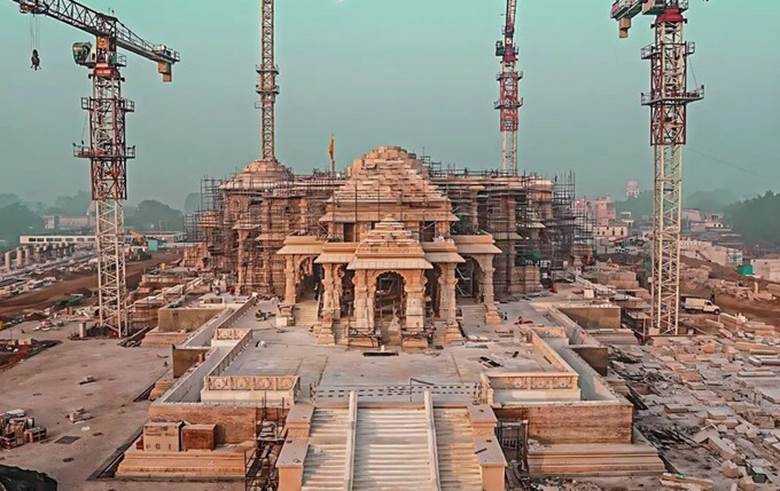
The Ram Mandir Hindu temple under construction in Ayodhya, India
India to Open ‘Hindu Vatican’ in Ayodhya
Bilal Kuchay
Ayodhya, India
Narendra Modi is preparing to attend the opening of a vast new temple billed as the Vatican of Hinduism that he hopes will secure his victory in India’s upcoming elections.
Pilgrims bearing ornate gifts have already begun streaming into the Indian city of Ayodhya in their thousands ahead of the consecration of Ram Mandir, a sprawling complex built on the site of a 16th-century mosque that was razed by Hindu zealots more than 30 years ago.
The inauguration of the temple fulfils a long-standing promise by Mr Modi and his party to build a temple on the site that many Hindus believe to be the birthplace of Ram, one of their religion’s most revered deities.
But for India’s Muslim minority, the temple serves as an all-too-painful reminder of the sectarian divisions they fear are becoming more pronounced under Mr Modi’s rule.
Some 4,500 laborers have been toiling around the clock for months to finish the first part of the shrine in time for Mr Modi’s visit on Monday, when he will witness a statue of Lord Ram being placed in the shrine.
On the day The Telegraph visited, the streets of Ayodhya in India’s northern Uttar Pradesh state were awash with color , with saffron-yellow flags bearing the image of Ram fluttering from the buildings.
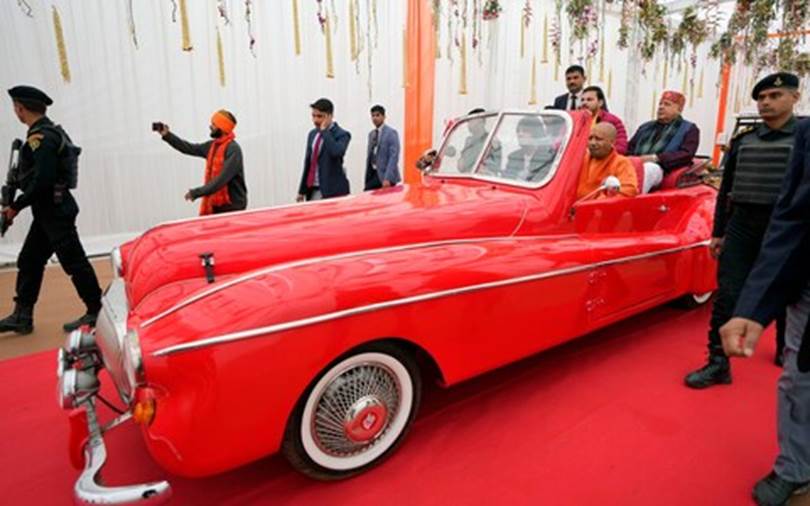
Yogi Adityanath, the Uttar Pradesh chief minister, arrives in saffron robes in a car ahead of Monday's opening of the temple dedicated to Hindu deity Lord Ram Credit - AP Photo/Rajesh Kumar Singh
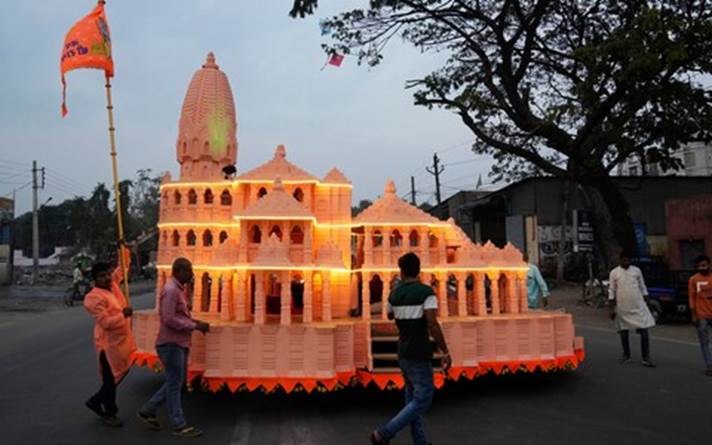
Devotees with a model of the new temple - AP Photo/Mahesh Kumar
Funded by donations, the temple is expected to cost over £300 million. So far, only the first floor of the three-storey building has been completed.
But even in its unfinished state the complex has taken on an unparalleled significance as a religious site.
Manish Kumar Namdev, a 33-year-old laborer, walked for two weeks to reach Ayodhya from Nagpur – a journey of almost 500 miles.
With a flag in his hand and a garland around his neck, Mr Namdev chanted “Jai Shri Ram” (Hail Lord Ram) as he walked towards the temple. He said he had decided to visit to seek blessings after being unable to find work.
“I’m so happy to see the atmosphere here,” he said. “It’s a proud feeling for India. Modi is doing great work.”
Rajesh Yadav, a devotee who had travelled with his family from neighboring Madhya Pradesh, thanked Mr Modi and Yogi Adityanth, Uttar Pradesh’s chief minister, “for making our 500-year-old dream come true”.
Such is the extent of fervor inspired by the temple’s opening, that there have even been reports of dozens of pregnant women in Uttar Pradesh hospitals requesting caesarian sections for Monday to coincide with the auspicious event.
Lavish gifts have also poured in from across India, with one Gujarati farmer creating what is claimed to be the world’s largest incense stick – a 108-foot-long, three-and-a-half ton cylinder made of cow dung and ghee. Once lit, it is expected to burn for some 45 days.
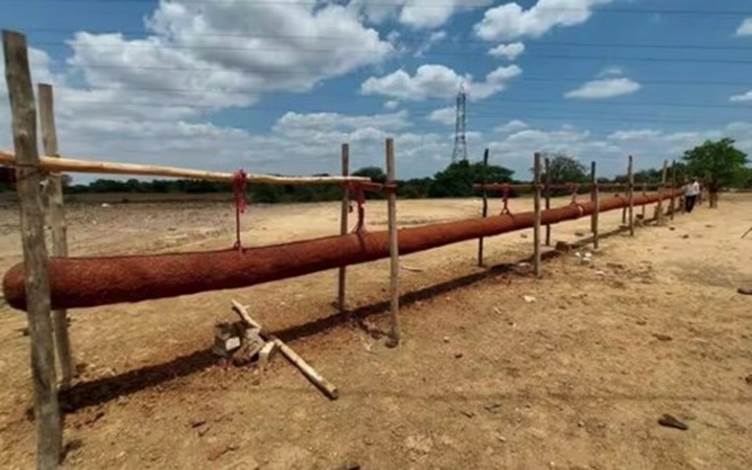
The 108ft long incense stick created for the opening
But while the Ram Mandir complex is a symbol of pride for many Hindus, it carries a different meaning for India’s Muslims.
In 1992, a rampaging Hindu mob tore down the Babri mosque erected by the Muslim ruler Babar that they believed had been built on the site of an earlier Hindu temple.
The razing of the Babri mosque sparked a wave of communal violence across the country, in which around 2,000 people were killed, most of them Muslims.
Despite a lack of evidence that there had ever been a Hindu temple on the site, India’s Supreme Court approved the construction of Ram Mandir in 2019 after years of litigation.
Simultaneously, a five-acre plot 15 miles from Ayodhya was designated for the building of a new mosque.
So far, construction work is yet to begin, with a small sign featuring blueprints of the planned mosque standing among grazing cattle the only sign of the concession granted to the Muslim minority.
Muslims say the court case has emboldened Hindu nationalists to lay claims over more Muslim religious structures which were allegedly constructed by destroying Hindu temples centuries ago.
“We are seeing more attacks on Muslim religious sites now,” said Mohammad Azam Qadri, president of the local Muslim body
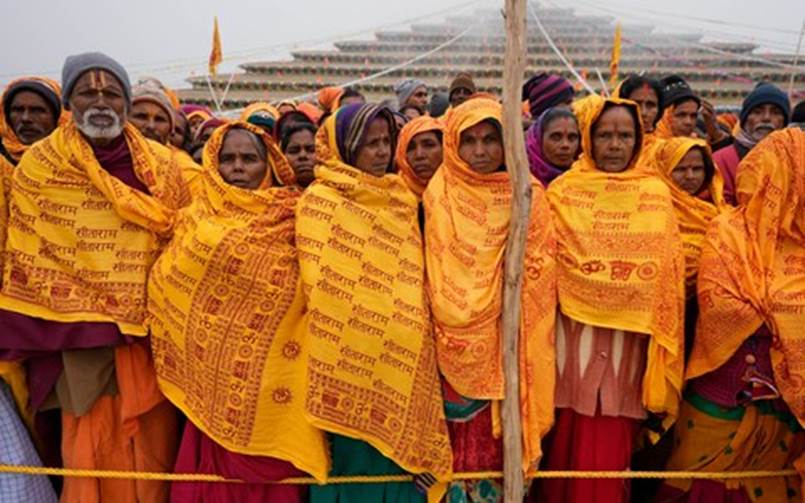
Hindu devotees have been gathering for the unveiling of the shrine - AP Photo/Rajesh Kumar Sing
Muslims in Ayodhya were living in fear and many had chosen to leave their homes ahead of the inauguration on Monday, said Mr Qadri, whose grandfather was a petitioner on the Muslim side in the Ayodhya case.
The temple has also proved divisive for some Hindus, who feel that the government’s push to capitalize on its opening to win election support has turned the site into a gimmick.
India’s top four Hindu spiritual leaders, or Shankaracharyas, have said they will not attend the inauguration ceremony as it was not being done according to Hindu scripture.
Opposition politicians have also seized on the spectacle as evidence of the decline of secularism as enshrined in India’s post-independence constitution.
Top leaders of the Congress, India’s main opposition party, declined an invitation to the ceremony, dismissing it as “a political project” of Mr Modi’s Bharatiya Janata Party (BJP) and Rashtriya Swayamsevak Sangh, the far-Right Hindu nationalist group.
Despite its divisive nature, Mr Modi is betting big that the temple will prove a vote winner ahead of India’s elections in a few months.
“The opening of the Ayodhya temple months before general elections underlines its political and religious significance in building Hindu nationalist momentum ahead of the polls,” said Zoya Hassan, a political analyst and former professor of political studies at Delhi’s Jawaharlal Nehru University. “The hype will help in consolidation of the Hindu vote in the [Hindi] heartland.”
For Rakesh Sinha, a BJP MP, the construction of the Ram Temple is part of a grand ambition for the civilizational revival of Hindu society.
“Hindus – for the first time under Modi – are feeling their own cultural freedom,” he told The Telegraph. - The Telegraph

